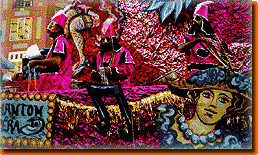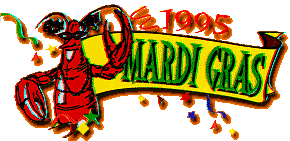

Tripod Home | New | TriTeca | Work/Money | Politics/Community | Living/Travel | Planet T | Daily Scoop

![]()
![]()
There's no single district in New Orleans where people go to eat, or to drink, or to dance. Nightclubs are spread out everywhere, some on the highly traveled strips and others tucked in hard-to-find corners, even under expressway ramps. Some are holes-in-the-wall, and others have the air of barns, with high ceilings and shabby floors. Few have places to sit. Depending on the size of the room and the size of the crowd, you'll either dance or bounce as you listen to jazz or blues, or to some uniquely New Orleans sounds like a "second-line" jazz brass band, or a "zydeco" group with an accordion, a washboard, and a pounding beat. People of all ages go out to dance here; on a typical night in Tipitina's (a cavernous, barnlike club) or Mid-City Lanes Rock 'n Bowl (a vintage 1950s bowling alley with a pair of stages), bunches of college students share the floor with middle-aged couples who have been two-stepping for decades. Artists of all kinds play everywhere--a club might have a brass band one night, a rock band the next, and a Latin band the next.
Artists of all kinds play everywhere--a club might have a brass band one night, a rock band the next, and a Latin band the next.
With or without music, bars are spread all over, usually alone at the ends of blocks, or in clumps of two or three. In the French Quarter, of course, they're packed more like sardines. The Quarter is the first destination of most New Orleans tourists, who spend their vacations wandering the Bourbon Street bar scene and marveling at the city's lack of an open-container law. Locals travel a few blocks riverward to Decatur Street, where baseball-capped tourists give way to nose-pierced natives and things seem a little calmer, if no less crazy.
Next to music, food is New Orleans's most famous offering, and food is plentiful. Scores of good restaurants serve Creole dishes and seafood, as would be expected, but also Japanese, French, and other ethnic fare. There are a few very expensive restaurants, but in general, food here is reasonably priced. A typical dinner in a typical cafe costs about $10 per person.
For other entertainment, New Orleans has a few museums, mostly historical and targeted at tourists. There's also one art museum, small and overhyped. Two parks inside the city's borders are suitable for jogging, biking, golf, and bird-watching; a national park across the river is great for a view of the swampy surroundings.  There are several shopping malls in the city and suburbs, and it's easy to spend a day wandering French Quarter galleries or the weekend open-air French Market. On the other side of the city, Magazine Street has blocks full of antique shops and art stores.
There are several shopping malls in the city and suburbs, and it's easy to spend a day wandering French Quarter galleries or the weekend open-air French Market. On the other side of the city, Magazine Street has blocks full of antique shops and art stores.
The city and suburbs are also full of movie theaters - a few that play non-mainstream flicks, one that hosts a fall film festival, and several dollar theaters scattered around the suburbs. Some non-mainstream films take a while to get down here, but most make it eventually. There's live theater in a few spots, and a major downtown theater carries a Broadway subscription series.
New Orleans isn't much of a theater town, though, and it isn't much of an intellectual town, despite the number of colleges nearby. In coffee shops on scattered corners, you might hear pinings for lost revolutions, or critiques of authors with greater reputations than Anne Rice's. But you're far less likely to overhear talk about national politics. New Orleans is a provincial town whose newspaper is more interested in the city and its outskirts than the outside world, and whose citizens seem to feel the same. It's not surprising; Louisiana politics provide more than enough entertainment.

![]()
![]()
Mardi Gras, New Orleans' biggest claim to fame, is probably America's most uninhibited holiday. It's a time for people to dress in wacky costumes in broad daylight - and a time for some, if willing and provoked, to take off certain strategic items of clothing for a dubious reward:  a string of plastic beads. Mardi Gras is fun, but New Orleans is actually much better once the parades roll out and the tourists leave and the street sweepers clear away the mountains of trash. During Mardi Gras, people pay too much attention to the parades and the alcohol, and not enough to the city behind it.
a string of plastic beads. Mardi Gras is fun, but New Orleans is actually much better once the parades roll out and the tourists leave and the street sweepers clear away the mountains of trash. During Mardi Gras, people pay too much attention to the parades and the alcohol, and not enough to the city behind it.
Mardi Gras does cut to New Orleans' roots; it's a Catholic-based holiday for a Catholic city. "Fat Tuesday" is the day before Ash Wednesday - the last day of fun before the first day of Lent. Carnival season - when people start decorating their homes and bringing giant danishes called "King Cakes" to work --begins precisely 12 days after Christmas. The day after Mardi Gras, many New Orleanians file into church, penitent and hung-over. In between the parties, faith is important here, especially in the suburbs. Public meetings are likely to begin with invocations, and despite the huge numbers of Catholic schools, there's a growing movement to bring prayer back into public school classrooms.
This seems the perfect way to be Catholic, though: all the ceremony with little of the guilt. Unlike the Puritanical cities of New England, where the bars close early and often - and where you're only allowed to enjoy yourself so much - New Orleans seems obsessed with worldly pleasures. Alcohol flows freely here, and music starts late, ends late, and plays everywhere. This is a city filled with young people, but it's also filled with older people who feel, act, and live young.
Map | Search | Help | Send Us Comments